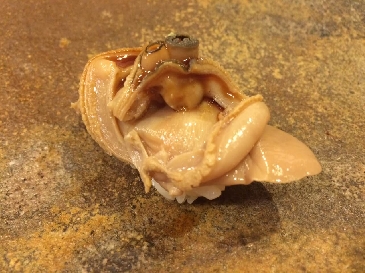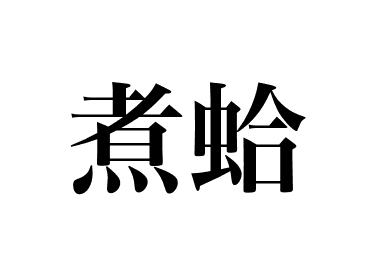Simmered


Common orient clam (Nihamaguri)
【Nigiri sushi: Nimono】
What is Hamaguri?
Hamaguri prefers depths of about 10 meters in the sandy and muddy areas of inner bays where freshwater flows into the saltwater. Until the 1960s, Tokyo Bay was famous for digging for hamaguri at low tides. This has been destroyed due to land reclamation, etc. Furthermore, nearly all hamaguri that can be harvested in Japan are open-sea ‘chosen hamaguri’ (common shield-clam), and Japan’s original hamaguri has become somewhat of a fairy tale.
The majority of hamaguri sold on the market nowadays are chosen hamaguri (common shield-clam) imported from South Korea, or shina hamaguri (hard clam) imported from China. Once imported to Japan, they are released to inshore waters and kept as livestock. It is a well-known fact that when clams from Korea are heated, they shrink to pitiful sizes. When Japanese hamaguri are grilled, they swell in size so much it seems like they will jump out of the shells.
What does Nihamaguri (Common orient clam) nigiri sushi taste like?
Common orient clam (Hamaguri) was once harvested in abundance from Tokyo Bay, even today is a fundamental ingredient in Edomae sushi. After boiled or steamed with sake, clams are dipped in a special sauce of soy sauce, sake and sugar. Clams become tender, take on a fluffy texture and rich ocean flavor. With each bite, you can enjoy the tastiness of the clam.
Hamaguri is a type of sushi that requires a great deal of skill in terms of how to shuck it, prepare it, make it, and the flavor of the Tsume that is applied on top. Unlike Anago's Tsume, the soy sauce-based broth is used up before the next batch is made.
Also called Japanese hard clam.
【Related contents】
What is Tsukudani?
List of Nimono, Gyoran and Others
(Revision date: December 30, 2023)
Main production area
Aichi Mie Chiba
Famous production area
Kashimanada Kuwana Funabashi Sanbanze
Season
Spring-Early summer

